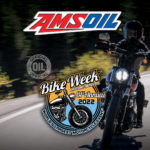Big temperature swings are common in much of North America. In February 2011, the town of Nowata, Okla. saw a record low of -31ºF (-35ºC). Just a week later the temp climbed to 79ºF (26ºC). That’s a 110ºF (61ºC) swing in only a week. The underlying concern for motorists is that ambient temperature changes will permanently degrade engine oil. So, is it possible?

When using AMSOIL synthetic lubricants, the short answer is no. But, if your customer is using conventional oil, the answer is much longer and can get a little muddy. To illustrate, suppose you had been in Nowata during that record-setting week and you had been using conventional oil. Early in the week, the oil would have thickened in the cold – maybe enough to prevent the engine from starting. If the engine had started, the oil pump could have sheared the ultra-thick oil, permanently reducing its viscosity. Oil that has lost viscosity can fail to provide adequate wear protection, placing your engine at risk. By the weekend, with the temperature rising, you had shed your winter coat and broken out the shorts. Feeling energized, you loaded the UTVs on the trailer and decided to hit the trailhead. The warmer temps, combined with towing, could have increased your engine’s operating temperature enough to oxidize the oil, permanently increasing its viscosity.

This leads to reduced fuel efficiency since the engine has to work harder to circulate the thicker oil. It also increases oil temperature, further hastening chemical breakdown, which invites harmful deposits and reduces the oil’s service life. Oil formulators know that temperatures change continually. Extreme temperatures are common all over the world, and we don’t want oil to permanently change viscosity due to your local weather. This is why oil is designed to temporarily change with the temperature – in large part due to formulating oil with viscosity-index (VI) improvers.

Here’s how it works. VI improver additives contract when it’s cold, allowing the viscosity to decrease, or become thinner. This ensures the oil flows readily and provides protection to critical components when you start the engine. It also ensures the oil pump doesn’t shear the oil and permanently reduce its viscosity. As the temperature increases, VI improvers relax and slow the rate at which the lubricant’s viscosity decreases. Think of VI improver additives like springs. They contract when cold, but stretch when hot. As they stretch out inside the lubricant, they bump into each other and strategically control viscosity.
VI improvers sound great, but they can have drawbacks. Low-quality VI improvers are prone to mechanical shear. As the oil is squeezed through tight tolerances, like the piston ring/ cylinder wall interface, the pressure can tear apart, or shear, the VI improvers.
Continuing with our spring analogy, imagine cutting a spring in half. The two pieces will still stretch, but not nearly as much as a complete spring. As a result, the oil loses high temperature viscosity. Eventually your 5W-40 oil may become a 5W-30. Permanent viscosity loss from shear is not good. Viscosity influences the oil’s fluid film, which helps prevent metal-tometal contact and wear. Every original equipment manufacturer designs its engines with specific clearances designed to be filled by a specific viscosity of oil. If the VI improvers shear too much, viscosity decreases, inviting engine wear. Like base oils, VI improvers come in a range of qualities.
We use high-quality VI improvers that resist shear despite intense stress. As a result, AMSOIL synthetic oils maintain viscosity to provide excellent wear protection despite the weather outside. So, big temperature changes can affect engine oil, but it’s something we know and can design around. AMSOIL synthetic


